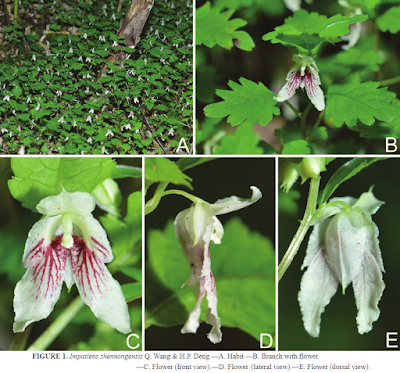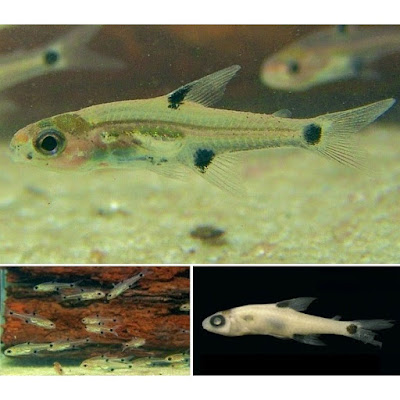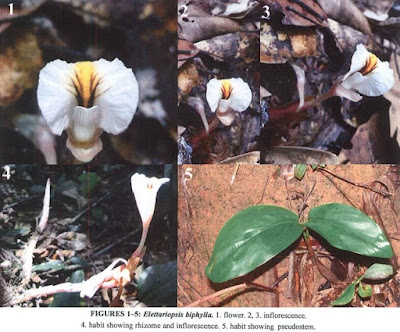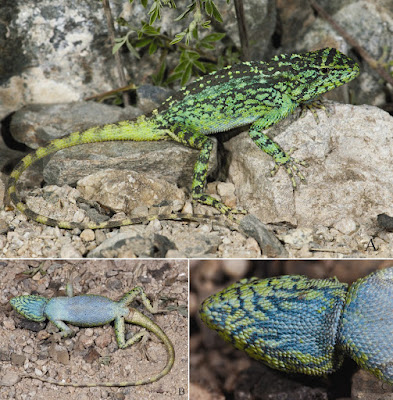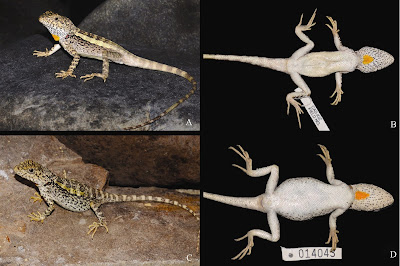[Most Recent Entries] [Calendar View]
Friday, July 8th, 2016
| Time | Event | ||||
| 12:30a | [Botany • 2016] Impatiens shennongensis • A New Species (Balsaminaceae) from Hubei, China
Abstract A new species of the genus Impatiens is described from Hubei province, China. Although it shares some features with I. dicentra, such as single-flowered peduncles and a filamentous bristle terminating the upper of the lateral united petals, it possesses distinct traits such as shorter plant height, rhombic to sub-rhombic leaves, lateral sepals entire, and lower sepals navicular without a spur. We believe that this is a new addition to the speciose Impatiens genus, and propose the name Impatiens shennongensis Q. Wang & H.P. Deng. We also describe the new species in this paper in terms of SEM-based seed and pollen micromorphology. Keywords: Balsaminaceae, China, Hubei, Impatiens shennongensis sp. nov., Eudicots Diagnosis: The new species is similar to Impatiens dicentra in having single-flowered peduncles and the upper of the lateral united petals being terminated by a filamentous bristle. However, the differentiating characteristics are that I. shennongensis has a shorter plant height (15–30 cm), with leaves rhombic to sub-rhombic in shape, lateral sepals entire, and navicular lower sepals without a spur. In contrast, I. dicentra is taller (60–90 cm), with ovate or ovate-lanceolate shaped leaves, lateral sepals margins coarsely dentate, lower sepals saccate and constricted into an incurved spur. Etymology:— The epithet shennongensis refers to the type locality, Shennongjia Forest Region, which is rich in plant diversity (Zhao 2002). Phenology:— Flowering and fruiting from July to October. Ecology and Distribution:— The new species occurs at margins of bamboo forests, about 2500 m in elevation. It is currently only known to exist in a small population in the Shennongjia Forest Region. Phenetic relationships:— Impatiens shennongensis is similar to I. dicentra Franchet ex Hooker f. (1908: 268) in some traits such as single-flowered peduncles and the upper of the lateral united petals being terminated by a filamentous bristle. However, the former differs in the following characters: plant height (much shorter: 15–30 cm vs. 60–90 cm); leaf blades (rhombic or sub-rhombic vs. ovate or ovate-lanceolate); leaf margins (coarsely crenate, teeth 2-lobed, and mucronate between lobes vs. crenate-serrate, teeth mucronulate); margins of lateral sepals (entire vs. coarsely dentate); lower sepals (navicular, spur absent vs. saccate, constricted into an incurved, short, 2-lobed spur); flowers (1–1.5 cm long, white with fuchsia striate vs. flowers 4 cm long, yellow). Qian Wang, Sudhindra R. Gadagkar, Hong-Ping Deng, Zhi-ming Yang and Feng-Qiong Yu. 2016. Impatiens shennongensis (Balsaminaceae): A New Species from Hubei, China. Phytotaxa. 244(1); 96-100. DOI: 10.11646/phytotaxa.244.1.8 | ||||
| 6:06a | [Ichthyology • 2008] Amazonspinther dalmata • A New Genus and Species of Characid Fish from the Amazon Basin - the Recognition of A Relictual Lineage of Characid Fishes (Cheirodontinae: Cheirodontini)
ABSTRACT Amazonspinther dalmata, a new miniature characid from the streams of rio Purus and rio Madeira, right bank tributaries of the rio Amazonas, is described as a new genus and species of the subfamily Cheirodontinae. The unique characters of the new genus and species are the three remarkable black blotches on the base of the dorsal, anal, and caudal fins, the anteriormost proximal radial of the anal fin with an anteriorly extended lamina entering the abdominal cavity, and the extremely elongate caudal peduncle. The reduced number of ventral procurrent caudal-fin rays (7-9), and the hemal spines of only posterior one, two, or sometimes three caudal vertebrae directly articulating with the ventral procurrent caudal-fin rays further diagnoses the new taxon from remaining genera of the tribe Cheirodontini. The results of a phylogenetic analysis strongly support a close relationship between A. dalmata and Spintherobolus in the tribe Cheirodontini on the basis of fifteen unambiguous synapomorphies. Ten of these characters, previously hypothesized as exclusive synapomorphies for Spintherobolus, were now also identified in Amazonspinther, such as the pattern of exposed neuromasts on the head, the presence of a second pseudotympanum anterior to the first pleural rib, and the nearly discoidal coracoid bone. A discussion about the phylogenetic position of the closely related fossil †Megacheirodon to Spintherobolus and Amazonspinther is also provided. Convergent characters shared between Amazonspinther and the characid Priocharax are discussed in relation to miniaturization. Biogeographical implications of the diversification of Amazonspinther, Spintherobolus, and Megacheirodon lineages are discussed. Key words: Phylogeny, Biogeography, Miniaturization, Spintherobolus, Priocharax. Amazonspinther, new genus Diagnosis. Amazonspinther is diagnosed among all characid species by the autapomorphic presence of three conspicuous black blotches on the base of the dorsal, anal, and caudal fins (ch. 43; Fig. 1). Amazonspinther is diagnosed among all genera of the Cheirodontinae by two uniquely derived characters, the anteriormost proximal radial of the anal fin with an anteriorly extended lamina entering the abdominal cavity, between the distal portions of the 12th to 14th pleural ribs (ch. 44; Fig. 2) (vs. short anteriorly extended lamina, not entering the abdominal cavity and not between pleural ribs), and by the extremely elongate caudal peduncle, corresponding to 27.3-30.2% of SL. Caudal peduncle length is comparatively short in cheirodontines, ranging from 11.0 to 19.6% of SL. Spintherobolus papilliferus has an elongate caudal peduncle (21.3-27.0% of SL), but shorter than that observed for Amazonspinther. Among all genera of the tribe Cheirodontini, Amazonspinther is diagnosed by two features: a small number of ventral procurrent caudal-fin rays (7-9 vs. 11-28; Malabarba, 1998:205-207, 209, ch. 42; Weitzman & Malabarba, 1999:8-9, ch. 5; 11-16 in Spintherobolus species) (Fig. 3); and hemal spines of one, two, or sometimes three posterior caudal vertebrae directly articulating with the ventral procurrent caudal-fin rays (Fig. 3; vs. hemal spines of at least the four posterior caudal vertebrae directly articulating with the ventral procurrent caudal-fin rays). Etymology. Amazon, in reference to the Amazon basin, and spinther from the Greek spinther, masculine, meaning sparks, fire, in reference to both the closely related genus Spintherobolus and to the appearance of the yellow neuromasts of the head, also observed in Spintherobolus (Fig. 4). Amazonspinther dalmata, new species Etymology. The epithet refers to the Portuguese word "dalmata", in allusion to the color pattern of the skin of the dogs of the Dalmatian breed which resembles the color of A. dalmata. The origin of this word is linked to the Dalmatia region currently in Croatia, where the dog breed was possibly developed. A noun in apposition. Distribution. Amazonspinther dalmata is known from small streams of middle rio Purus (rio Açuá) and middle and lower rio Madeira basins, State of Amazonas, Brazil (Fig. 8). Ecological notes. The holotype of Amazonspinther dalmata was collected syntopically with several characid species, such as Axelrodia lindeae, Iguanodectes spp., Microschemobrycon geisleri, Tyttocharax madeirae, Gnathocharax steindachneri, Phenacogaster beni, Hemigrammus sp., Knodus sp., and with the crenuchids Odontocharacidium aphanes, Elachocharax pulcher, Ammocryptocharax elegans, and Microcharacidium sp. The type locality was characterized by possessing slow current, muddy substratum, and silty, turbid water. There was abundant riparian vegetation, and the maximum depth was 1.3 m (Fig. 9). The site of collection in the tributary of rio Purus (MCP 37572) had perceptible current, some submerged vegetation, transparent water, sandy and muddy substratum, riparian vegetation, and a maximum depth of 1 m. Cristina M. Bührnheim, Tiago P. Carvalho, Luiz R. Malabarba and Stanley H. Weitzman. 2008. A New Genus and Species of Characid Fish from the Amazon Basin - the Recognition of A Relictual Lineage of Characid Fishes (Ostariophysi: Cheirodontinae: Cheirodontini). Neotrop. ichthyol. 6(4); DOI: 10.1590/S1679-62252008000400016 RESUMO: Amazonspinther dalmata, um novo caracídeo miniatura de igarapés dos rios Purus e Madeira, afluentes da margem direita do rio Amazonas, é descrito como um novo gênero e nova espécie da subfamília Cheirodontinae. Os caracteres únicos ao novo gênero são as manchas pretas conspícuas na base das nadadeiras dorsal, anal e caudal, o radial proximal mais anterior da nadadeira anal com uma lâmina estendida anteriormente entrando na cavidade abdominal e o pedúnculo caudal extremamente alongado. Caracteres adicionais que diagnosticam o novo táxon dos demais gêneros da tribo Cheirodontini incluem o número reduzido de raios procorrentes caudais (7-9) e os espinhos hemais de somente uma, duas, ou às vezes três das vértebras caudais, diretamente articulados com os raios procorrentes caudais ventrais. Os resultados de uma análise filogenética suportam fortemente uma relação de proximidade entre A. dalmata e Spintherobolus na tribo Cheirodontini com base em quinze sinapomorfias não ambíguas. Dez destes caracteres foram previamente propostos como sinapomorfias exclusivas de Spintherobolus, mas agora são reconhecidos também em Amazonspinther, e.g. o padrão de distribuição de neuromastos expostos na cabeça, o segundo pseudotímpano anterior à primeira costela pleural e o coracóide aproximadamente discóide. Uma discussão a respeito da posição filogenética do fóssil †Megacheirodon, proximamente relacionado a Spintherobolus e Amazonspinther, também é fornecida. Caracteres convergentes entre Amazonspinther e o caracídeo Priocharax são discutidos com relação à miniaturização. Implicações biogeográficas da diversificação das linhagens Amazonspinther, Spintherobolus e Megacheirodon são discutidas. | ||||
| 9:15a | [Botany • 2014] Elettariopsis biphylla • A New Species of Zingiberaceae from Thailand Abstract A new species of Elettariopsis from Phu Wua Wildlife Sanctuary, Bung Khla District, Bueng Kan Provice, Thailand is described as a new species. The new species is similar to E. monophylla (Gagnep.) Loesener (1930: 603), but differs in having two leaves and dark red veins in parts of the labellum, in the length of the petioles, the tall pseudostem and the apex of the anther-crest. Differences are pointed out in Table 1. The species is locally rare occurring in lowland Phuwou forest. It is described and illustrated below. Keywords: Elettariopsis, Zingiberaceae Elettariopsis biphylla S.Saensouk & P.Saensouk, sp. nov. (Figs. 1–6) The species has two distinctive leaves and dark red veins in parts of the labellum. The morphological characters of Elettariopsis biphylla are similar to those of E. monophylla but it differs in its two leaves, dark red veins in parts of the labellum and length of petioles, the pseudostem and the apex of the anther crest. Type:—THAILAND. Bueng Kan Province: Bung Khla District, Phu Wua Wildlife Sanctuary, levation 140 m.,May 2013, Saensouk 400 (holotype BK!, isotypes BKF!, KKU!, QSBG!). S. Saensouk and P. Saensouk. 2014. Elettariopsis biphylla, A New Species of Zingiberaceae from Thailand. Phytotaxa. 159(1): 023–025. DOI: 10.11646/phytotaxa.159.1.4 | ||||
| 10:25a | [Botany • 2016] Caulokaempferia kayinensis & C. monensis • The Genus Caulokaempferia (Zingiberaceae) in Myanmar Part 1: Two New Species from South Myanmar Two new species, Caulokaempferia kayinensis Picheans. & Sangnark and C. monensis Picheans. & Sangnark (Zingiberaceae), are described. This is the first report of the genus from Myanmar. The sessile inflorescence of C. kayinensis, hidden in the uppermost two leaf sheaths, is unique among the yellow-flowered group of the genus. The long ligule, ovate bract, and the bract-formation on inflorescence are characteristic of C. monensis. Full descriptions, together with ink line-drawings with water-color and photographic illustrations, of these new taxa are given. Key words: Caulokaempferia, Caulokaempferia kayinensis, Caulokaempferia monensis, Kayin State, Mon State, south Myanmar, Zingiberaceae. Supatthra Sangnark, Sittichoke Prasarn, Boonmee Phokham, Pornpimon Wongsuwan and Chayan Picheansoonthon. 2016. The Genus Caulokaempferia (Zingiberaceae) in Myanmar Part 1: Two New Species from South Myanmar. J. Jpn. Bot. 91: 133–140. http://www.jjbotany.com/pdf/JJB_091_issu | ||||
| 3:16p | [Herpetology • 2016] Japalura iadina & J. laeviventris • Two New Species of Japalura (Squamata: Agamidae) from the Hengduan Mountain Range, China
ABSTRACT Until recently, the agamid species, Japalura flaviceps, was recognized to have the widest geographic distribution among members of the genus occurring in China, from eastern Tibet to Shaanxi Province. However, recent studies restricted the distribution of J. flaviceps to the Dadu River valley only in northwestern Sichuan Province, suggesting that records of J. flaviceps outside the Dadu River valley likely represent undescribed diversity. During two herpetofaunal surveys in 2013 and 2015, eight and 12 specimens of lizards of the genus Japalura were collected from the upper Nujiang (=Salween) Valley in eastern Tibet, China, and upper Lancang (=Mekong) Valley in northwestern Yunnan, China, respectively. These specimens display a unique suite of diagnostic morphological characters. Our robust comparisons of phenotype reveal that these populations can be distinguished readily from J. flaviceps and all other recognized congeners. Here-in, we describe the two Japalura lineages as new species, Japalura laeviventris sp. nov. and Japalura iadina sp. nov.. In addition, we provide updated conservation assessments for the new species as well as imperiled congeners according to the IUCN criteria for classification, discuss the importance of color patterns in the diagnosis and description of species in the genus Japalura, and discuss directions for future taxonomic studies of the group. Keywords: Coloration; Conservation; Hengduan Mountains; Hydropower development; Japalura flaviceps
Japalura laeviventris sp. nov. Wang, Jiang, Siler, and Che Synonyms: Japalura flaviceps Pope, 1935: 467; Zhao & Jiang, 1977: 293-298; Hu et al., 1987: 112; Zhao et al., 1999: 111-115; Li et al., 2010: 115. Diagnosis: Following Inger’s definition of the genus (Inger, 1960) , the new species is assigned to the genus Japalura based on a number of diagnostic characters, including: (1) dorsal scales unequal in size; (2) enlarged crest scales present; (3) gular pouch present; (4) lateral fold of skin in axilla-groin region present; (5) supraciliary scales greatly imbricate;(6)head relatively long, flat; (7) tail long, slender; (8) tail cylindrical in shape; and (9) precloacal and femoral pores absent. Distribution and Natural History: Japalura laeviventris sp. nov. is known only from its type locality in the upper Nujiang Valley (Figure 1); however, the species may also occur along geographically proximate stretches of Nujiang. Little vegetation exists in the Hot- and -Dry Valley (Figure 4). The new species is terrestrial, with individuals have been observed on the s and y hills alongside the river, utilizing rock crevices and rodent burrows as shelters. No larger reptiles have been recorded from the area. Males of the new species are more conspicuous in behavior than females, and can be observed basking for greater lengths of time in open habitat. In contrast, females appear to stay in closer proximity to shelters. Etymology: We derive the new species name from the Latin word “laeviventris, ” meaning “smooth venter, ” in reference to one of the major diagnostic characteristics of the new species: smooth or weakly keeled ventral body scales. Suggested common name: Smooth-venter Mountain Dragon (English); Hua Fu Pan Xi (Chinese; 滑腹攀蜥). Japalura iadina sp. nov. Wang, Jiang, Siler, and Che Synonyms: Japalura flaviceps Zhao et al., 1999: 293-298; Yang and Rao, 200: 200-201; 8; Xu and Zhang 2011: 202-203; Japalura splendida Xu and Zhang 2011: 202-203; Japalura cf. flaviceps Manthey et al., 2012 Diagnosis: Following Inger’s (1960) definition of the genus, the new species is assigned to Japalura based on a number of diagnostic characters, including: (1) dorsal scales unequal in size; (2) enlarged crest scales present; (3) gular pouch present; (4) lateral fold of skin in axilla-groin region present; (5) supraciliary scales greatly imbricate; (6) head relatively long, flat; (7) tail long, slender; (8) tail cylindrical in shape; and (9) precloacal and femoral pores absent. Distribution and natural history: Although locally abundent, Japalura iadina sp. nov. is known only from the type locality (Figure 1). The new species is terrestrial, inhabiting dry, rocky habitats along the Lancang River (Figure 7). The emerald green coloration of the males makes them st and out from the rocky, environmental background. Tail autotomy has been observed for this population. Etymology: The Latin name “iadina” means “emerald like,” which describes the diagnostic emerald green body coloration of males of the new species. Suggested common name: Emerald Mountain Dragon (English), Fei Cui Pan Xi (Chinese; 翡翠攀蜥). Kai Wang, Ke Jiang, Dahu Zou, Fang Yan, Cameron D Siler and Jing Che. 2016. Two New Species of Japalura (Squamata: Agamidae) from the Hengduan Mountain Range, China. Zoological Research. 37(1): 41–56. | ||||
| 4:01p | [Herpetology • 2013] Pseudocalotes andamanensis • Rediscovery of Calotes andamanensis Boulenger, 1891, from the Andaman Islands (India), and Assessment of its Generic Allocation The little known draconine agamid lizard Calotes andamanensis Boulenger, 1891, was rediscovered from the Andaman Islands (India). The authors present morphometric and meristic data from six specimens originating from three islands of the Andaman Archipelago, and thereby add information to the description of the type specimen. The lizard's external morphology suggests that its generic assignment to Calotes in its present definition can-not be maintained and that this species should better be included in the genus Pseudocalotes. Key words: reptilia, squamata, sauria, Agamidae, Harikrishnan Surendran and Karthikeyan Vasudevan. 2013. Rediscovery of Calotes andamanensis Boulenger, 1891, and Assessment of its Generic Allocation. Herpetozoa. 26(1/2):3-13. |
| << Previous Day |
2016/07/08 [Calendar] |
Next Day >> |
